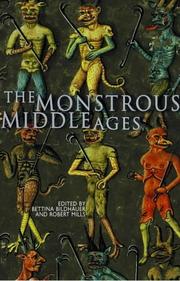| Listing 1 - 5 of 5 |
Sort by
|
Book
ISBN: 022616926X 9780226169262 9780226169125 022616912X 9780226169125 Year: 2015 Publisher: Chicago
Abstract | Keywords | Export | Availability | Bookmark
 Loading...
Loading...Choose an application
- Reference Manager
- EndNote
- RefWorks (Direct export to RefWorks)
During the Middle Ages in Europe, some sexual and gendered behaviors were labeled "sodomitical" or evoked the use of ambiguous phrases such as the "unmentionable vice" or the "sin against nature." How, though, did these categories enter the field of vision? How do you know a sodomite when you see one? In Seeing Sodomy in the Middle Ages, Robert Mills explores the relationship between sodomy and motifs of vision and visibility in medieval culture, on the one hand, and those categories we today call gender and sexuality, on the other. Challenging the view that ideas about sexual and gender dissidence were too confused to congeal into a coherent form in the Middle Ages, Mills demonstrates that sodomy had a rich, multimedia presence in the period-and that a flexible approach to questions of terminology sheds new light on the many forms this presence took. Among the topics that Mills covers are depictions of the practices of sodomites in illuminated Bibles; motifs of gender transformation and sex change as envisioned by medieval artists and commentators on Ovid; sexual relations in religious houses and other enclosed spaces; and the applicability of modern categories such as "transgender," "butch" and "femme," or "sexual orientation" to medieval culture. Taking in a multitude of images, texts, and methodologies, this book will be of interest to all scholars, regardless of discipline, who engage with gender and sexuality in their work.
Sodomy --- Sodomy in art. --- Art, Medieval --- Vision in literature. --- Sodomy in literature. --- Literature, Medieval --- History and criticism. --- homosexual, sexuality, sex, intercourse, kink, taboo, history, historical, medieval, europe, european, international, global, western world, sodomite, vice, sin, religion, religious studies, anal, motif, visibility, culture, cultural, academic, scholarly, research, art, artistic, gender, multimedia, terminology, bible, illustrated, ovid, transgender, butch, femme, orientation, queer, literature, literary, analysis, monks.

ISBN: 1786831759 1786831740 9781786831750 9781786831743 9780708318225 Year: 2017 Publisher: Cardiff
Abstract | Keywords | Export | Availability | Bookmark
 Loading...
Loading...Choose an application
- Reference Manager
- EndNote
- RefWorks (Direct export to RefWorks)
English literature --- Monsters in literature. --- History and criticism.
Book
ISBN: 1628943556 9781628943559 Year: 2019 Publisher: New York
Abstract | Keywords | Export | Availability | Bookmark
 Loading...
Loading...Choose an application
- Reference Manager
- EndNote
- RefWorks (Direct export to RefWorks)
Book
ISBN: 0875868274 9780875868271 9780875868257 9780875868264 Year: 2011 Publisher: New York Algora Pub.
Abstract | Keywords | Export | Availability | Bookmark
 Loading...
Loading...Choose an application
- Reference Manager
- EndNote
- RefWorks (Direct export to RefWorks)
Conscience of a Conspiracy Theorist seeks to show how governmental deceit and (corporate-controlled) media silence have combined to keep the public misinformed about shocking events in American history. In the process, skeptics who question the ?official accounts? are labeled ?conspiracy theorists,? a pejorative term that carries with it suggestions of foolishness and a lack of patriotism.
Book
ISBN: 144265709X Year: 2003 Publisher: Toronto, Ontario : Ottawa, Ontario : University of Toronto Press, Canadian Electronic Library,
Abstract | Keywords | Export | Availability | Bookmark
 Loading...
Loading...Choose an application
- Reference Manager
- EndNote
- RefWorks (Direct export to RefWorks)
In this series of detailed studies, Andy Orchard demonstrates the changing range of Anglo-Saxon attitudes towards the monstrous by reconsidering the monsters of Beowulf against the background of early medieval and patristic teratology and with reference to specific Anglo-Saxon texts.
Monsters in literature. --- Heroes in literature. --- Pride in literature. --- Beowulf. --- Beowulf --- Manuscripts.
| Listing 1 - 5 of 5 |
Sort by
|

 Search
Search Feedback
Feedback About UniCat
About UniCat  Help
Help News
News